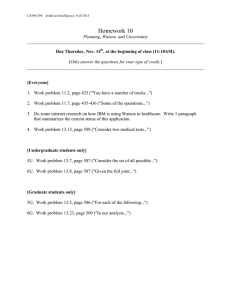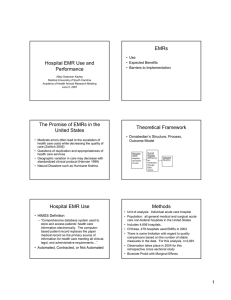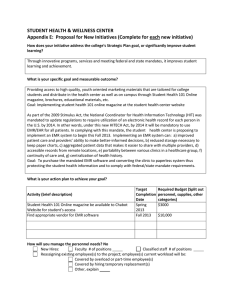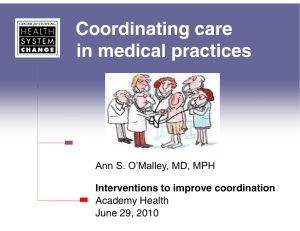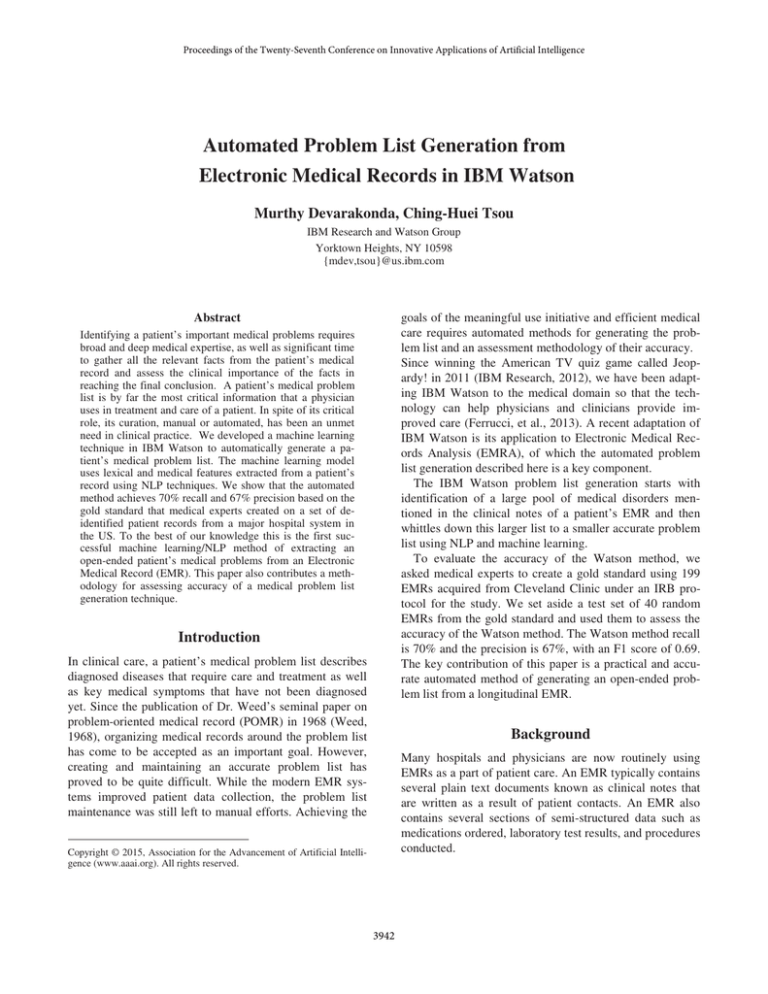
Proceedings of the Twenty-Seventh Conference on Innovative Applications of Artificial Intelligence
Automated Problem List Generation from
Electronic Medical Records in IBM Watson
Murthy Devarakonda, Ching-Huei Tsou
IBM Research and Watson Group
Yorktown Heights, NY 10598
{mdev,tsou}@us.ibm.com
Abstract
goals of the meaningful use initiative and efficient medical
care requires automated methods for generating the problem list and an assessment methodology of their accuracy.
Since winning the American TV quiz game called Jeopardy! in 2011 (IBM Research, 2012), we have been adapting IBM Watson to the medical domain so that the technology can help physicians and clinicians provide improved care (Ferrucci, et al., 2013). A recent adaptation of
IBM Watson is its application to Electronic Medical Records Analysis (EMRA), of which the automated problem
list generation described here is a key component.
The IBM Watson problem list generation starts with
identification of a large pool of medical disorders mentioned in the clinical notes of a patient’s EMR and then
whittles down this larger list to a smaller accurate problem
list using NLP and machine learning.
To evaluate the accuracy of the Watson method, we
asked medical experts to create a gold standard using 199
EMRs acquired from Cleveland Clinic under an IRB protocol for the study. We set aside a test set of 40 random
EMRs from the gold standard and used them to assess the
accuracy of the Watson method. The Watson method recall
is 70% and the precision is 67%, with an F1 score of 0.69.
The key contribution of this paper is a practical and accurate automated method of generating an open-ended problem list from a longitudinal EMR.
Identifying a patient’s important medical problems requires
broad and deep medical expertise, as well as significant time
to gather all the relevant facts from the patient’s medical
record and assess the clinical importance of the facts in
reaching the final conclusion. A patient’s medical problem
list is by far the most critical information that a physician
uses in treatment and care of a patient. In spite of its critical
role, its curation, manual or automated, has been an unmet
need in clinical practice. We developed a machine learning
technique in IBM Watson to automatically generate a patient’s medical problem list. The machine learning model
uses lexical and medical features extracted from a patient’s
record using NLP techniques. We show that the automated
method achieves 70% recall and 67% precision based on the
gold standard that medical experts created on a set of deidentified patient records from a major hospital system in
the US. To the best of our knowledge this is the first successful machine learning/NLP method of extracting an
open-ended patient’s medical problems from an Electronic
Medical Record (EMR). This paper also contributes a methodology for assessing accuracy of a medical problem list
generation technique.
Introduction
In clinical care, a patient’s medical problem list describes
diagnosed diseases that require care and treatment as well
as key medical symptoms that have not been diagnosed
yet. Since the publication of Dr. Weed’s seminal paper on
problem-oriented medical record (POMR) in 1968 (Weed,
1968), organizing medical records around the problem list
has come to be accepted as an important goal. However,
creating and maintaining an accurate problem list has
proved to be quite difficult. While the modern EMR systems improved patient data collection, the problem list
maintenance was still left to manual efforts. Achieving the
Background
Many hospitals and physicians are now routinely using
EMRs as a part of patient care. An EMR typically contains
several plain text documents known as clinical notes that
are written as a result of patient contacts. An EMR also
contains several sections of semi-structured data such as
medications ordered, laboratory test results, and procedures
conducted.
Copyright © 2015, Association for the Advancement of Artificial Intelligence (www.aaai.org). All rights reserved.
3942
An EMR usually contains a section for medical problems to be entered and maintained by physicians and clinical staff. In spite of its clear value, however, the problem
list section is rarely well maintained and almost always ignored by physicians (Campbell, 1998) (Meystre & Haug,
2008) (Holmes, 2011 Feb) (Holmes, 2011 Mar). Often
stated reasons include: lack of proper support from EMR
systems, lack of clarity of what goes on the list and when a
problem (if at all) comes off of the list, multiple authors,
and multiple and often contradictory uses of the list. Perhaps the fundamental reason is that it is a knowledge and
time intensive task requiring significant investment of an
expert’s time, which is always in short supply. Therefore, it
is a task that requires an automated and intelligent solution.
in all parts of an EMR – both in the plain text clinical notes
and in the remaining semi-structured clinical data. Terms
representing medical concepts are assigned one or more
Concept Unique Identifiers (CUIs) from the UMLS metathesaurus (US National Library of Medicine, 2009). CUI
mapping allows reasoning about medical concepts; for example, it becomes possible to recognize that the phrases
HTN, Hypertension, and High Blood Pressure all refer to
the same disease. Also, they can be categorized into semantic groups, e.g. as Disorders, Chemicals & Drugs, Procedures, etc. Each of these groups is further subcategorized, for example, Disorders are sub-grouped as
Diseases or Syndromes, Signs or Symptoms, Findings, and
others.
Mapping terms to CUIs is, in itself an interesting research
task. Both the CUI space and the term space are large and
the mapping is many-to-many. Using the context around a
term is often necessary to obtain a CUI that more accurately represents the concept. So, in Watson, in addition to the
standard NLP and UMLS lookup, we use additional contextual and sentence structural information to obtain a better mapping. (The details are beyond the scope of this paper.) A numerical score indicates how confident we are
that a CUI represents the original term, and it is used as a
feature in problem list generation. Once one or more CUIs
for a concept are identified, the CUIs are then mapped to a
SNOMED CT CORE (US National Library of Medicine,
2014) concept. If there is no exact match, we climb the
UMLS hierarchy until the closest parent that has a
SNOMED CT CORE concept is reached.
For a typical EMR, usually a few hundred candidate
problems are identified after the first step. When compared
to the final list, the problems generated in the first step
would have high recall (>90%) but poor precision (<10%).
The subsequent steps attempt to improve precision of the
problem list without substantial loss of recall.
In the second step, the method produces feature values
for the lexical and clinical features of the machine learning
model. An example lexical feature is the TF-IDF of a po-
Related Work
There are several efforts to define better coding systems to
represent medical problems (Campbell & Payne, 1994) and
there is even more recent activity to define a new coding
system based on a subset of SNOMED CT (US National
Library of Medicine, 2014). However, the closest work, i.e.
that of automation of problem list generation, is reported in
a series of papers by Meystre and Haug (Meystre & Haug,
2005) (Meystre & Haug, 2006) (Meystre & Haug, 2008).
The main result from the work of Meystre and Haug is
the identification of a patient’s medical problems in a specific domain (e.g. cardiovascular patients) from a list of
apriori identified problems using simple NLP techniques
and an assessment methodology of its accuracy. What is
common between their method and ours is that both analyze plain text clinical notes in patient medical records.
However, the key difference is that our goal is an openended problem list generation rather than limiting it to a
list of diseases specific to a domain or a patient population.
This difference is critical because the problem that is most
important for patient care may be outside the known domain.
Because our goal is an open-ended problem list generation, our method cannot simply search for disease terms
(and their semantic equivalents) from a list as in Meystre
and Haug. For example, our approach is not that of assessing if Myocardial Infarction is a problem for a patient,
but that of assessing if any of the diseases, syndromes,
symptoms, findings, or procedures appearing in a patient’s
EMR should be in the patient’s medical list. As our other
method is an open-ended problem list extraction and it is
necessary to apply advanced AI techniques.
Watson Problem List Generation
As shown in Figure 1, Watson problem list generation begins with an automated identification of medical concepts
Figure 1 Watson Problem List Generation Overview
3943
tential problem. An example clinical feature is the probability that at least one of the patient’s active medications is
a treatment for this potential problem. Key features are
listed and briefly described in Table 1 and further discussed later in the paper. We used the Alternating Decision
Tree (Freund & Mason, 1999) technique for its accuracy
and clarity of the decision process.
The reason for representing the generated problems as
the SNOMED-CT CORE concepts is that it is a result of
the efforts to define a standard vocabulary for documentation and encoding of clinical information at a summary
level, such as the problem list, discharge diagnosis, or the
reason for an encounter (US National Library of Medicine,
2014).
a selected problem, the note becomes the document and an
EMR becomes the corpus. For the problem list generation,
IDF is calculated using the entire de-identified EMR collection that we have.
Unlike a normal text document, an EMR is longitudinal
record and therefore, more recent notes are likely to better
represent the patient’s medical problems. Also, each note
in the EMR has implicit sections and so a concept (e.g. hypertension) appearing in different sections (e.g. family history vs. assessment and plan) may have significantly different meanings. Because of this, in addition to calculating
TF at the EMR level, TF is also calculated for each note
section and for a few different time periods.
Medical Features
Terms in the EMR semi-structured data are also mapped to
UMLS CUIs so that we can use the UMLS relations. Medications turn out to be one of the most important features,
whereas we saw no benefit from the lab tests and procedure orders. The first reason is that the medication names
are relatively standardized, even while mixing the generic
and brand names, and a UMLS CUI can be reliably found.
Conversely, labs and procedures are often specified in institution specific abbreviations instead of CPT codes and
LOINC codes, and are therefore harder to accurately map
to UMLS concepts. Second, medications are prescribed to
treat problems, while lab tests and procedures are often ordered to diagnose a problem and extensive domain
knowledge is needed to interpret their results. The relation
between a problem and a medication is derived from a
weighted confidence score obtained from distributional
semantics (Gliozzo, 2013) and UMLS relationships.
Features
Longitudinal EMRs are a rich source of information and a
lot of data can be extracted. Assembling this extracted data
into features with the appropriate type and level of aggregation is a practical question and crucial to success. Key
features that contributed to our final results are listed and
briefly described in Table 1. Each feature category is explained in more detail in this section.
Lexical Features
Standard TF-IDF formulation is used, where TF is normalized using the maximum frequency of any term in the document. TF-IDF reflects how important a term is to a document in a corpus. In our case, a term is a candidate problem. Depending on the goal, a document can be a note or
an EMR. When generating the problem list for a patient, an
EMR is a document and the entire collection of EMRs is
our corpus. When deciding which note is more relevant to
Frequency Features
Frequency of a problem can be thought of as the prior
probability that the patient may have it. Two sources of
frequency are used in our experiments. The first is the
SNOMED CORE usage (US National Library of Medicine,
2014), which represents the frequency in a broad population. The second is calculated using all diagnosed problems
(as ICD-9 codes) in our collection of EMRs, which represents the frequency in this particular institution.
Table 1 Description of the Key Features of the Model
!"#$%&"'
(")*&+,$+-.'
!&"/'0&-1'
!&"/%".$',&-12"3)'4$-,'567'-8'3-)$'8&"/%".$29'
:+#;.-)":',&-12"3)<=''
(+#;.-)":'
@A0B>'
>#)'"?"&'1"".':+#;.-)":'4)$&%*$%&":':#$#<'
0&-12"3'+)'8-%.:'+.'$C"',#)$'3":+*#2'C+)$-&9')"*D
$+-.'
0&-12"3'+)'&"2#$":'$-'#.9'#*$+?"'3":+*#$+-.'
B":'@*-&"'
E!DF(!'
E!'4G)$')"*$+-.<'
E!'4KL0<'
0OK'
!&"/'0&-1'
4OQJI<'
G)$'(#$"'
E!'
E!'4J"*".$<'
E!'4J"*".$V'J-@<'
Structural Features
The concept “diabetes mellitus” appearing in the assessment and plan (informal) section in a patient’s progress
note is a much stronger indicator that the patient has the
disorder than the same concept detected in the family history section in a nursing note. Since notes are in plain text
and note metadata is optional, the structures have to be
learned. Informal sections of a note are detected with regular expressions and heuristic rules. Note types are learned
using a Maximum Entropy classifier with the available
metadata, and several medical and lexical features from the
note text.
E"&3'!&"/%".*9'#.:'F.?"&)"':-*%3".$'8&"/%".*9''
E!H',&-12"3'#,,"#&)'+.'$C"'G)$')"*$+-.'-8'$C"'IBJ'
E!H',&-12"3'#,,"#&)'+.'$C"'M#))"))3".$'#.:',2#.N'
)"*$+-.'-8'$C"'IBJ'
0&-1#1+2+$9'-8'O-.*",$'8-&'#';+?".'$"&3'4*-?"&":'
$"P$<'
@RQBI('OQJI'%)#;"S'$C"'#?"&#;"'%)#;"',"&*".$D
#;"'#3-.;'#22'+.)$+$%$+-.)'
(#$"'4.-&3#2+T":<'$C"',&-12"3'+)'8+&)$'-**%&&":'
E"&3D8&"/%".*9
E!H',&-1='#,,"#&)'+.'$C"'&"*".$'42#)$'U'3-=<'.-$")'
E!H',&-12"3'#,,"#&)'+.'$C"'MJ"?+"W'-8'@9)$"3N'
)"*$+-.'+.'$C"'&"*".$'42#)$'U'3-.$C)<'.-$")'
3944
Temporal Features
The span of an EMR varies from a single day to several
decades. Most temporal features in our experiments are
normalized to prevent bias towards longer EMRs, but absolute value is also used to define certain features, e.g. note
recency, where the recency is defined as the number of
days from the latest patient contact.
Temporal data is used in three ways. First, it is used as
features directly. Temporal features considered include the
first/last mention of a problem, and the duration of a problem. Second, it is used to align semi-structured data and
structure data, e.g. a medication prescribed before a problem is mentioned in a note is not considered as evidence to
the problem. Third, temporal data is used to divide notes
into bins on the timeline so that frequency can be counted
by intervals, e.g. TF in recent notes vs. TF in earlier notes.
Figure 2 First two levels of our ADT model
stances correctly. The top level features in Figure 2 are all
intuitive – but it is important to understand that they are
not necessarily the most important features to determine
whether a candidate problem is, in fact, a patient’s active
problem – they simply work better for the easy instances.
Some less intuitive features also shed some light on how
EMRs are written. For example, it is a positive indicator, if
a problem appears in the first section, regardless of what
the section is. This is because many EMRs start by stating
the patient’s active concerns. Another example is the first
mention date because a patient’s past medical history are
often carefully documented in his/her first visit to the hospital.
Model
We construct problem list generation as a binary classification problem, i.e., for each candidate problem in an EMR,
the task is to classify it as a problem or a non-problem. We
initially used a SVM model (Cortes & Vapnik, 1995)
(Chang & Lin, 2011) with linear kernel, but soon favored
more human interpretable models. As the gold-standard is
expensive to get and the training data is limited, knowledge
coming from domain experts and error analyses become
critical to success – and both benefit from models that output human understandable decision process. Decision tree
and association rules based classifiers generate models
close to the way medical experts think, at the cost of usually lower accuracy. We observed performance similar to our
earlier SVM model by using alternating decision tree
(ADT) (Freund & Mason, 1999), which outputs an option
tree but has its root in boosting. The basic implementation
of ADT (Hall, et al., 2009) uses a decision stump as the
base learner and adaptive boosting to grow the tree iteratively. During a boosting iteration, ADT adds a splitter
node and corresponding prediction nodes to extend one of
the existing paths in the tree. The scores associated with
the prediction nodes are obtained from the rules.
Model parameters are selected using 10-fold crossvalidation. The number of iterations of ADT is set to 30
(from the ROC and the Recall-Precision graphs), and the
score threshold is set to 0.85, to maximize the training F1
score. A subset (some branches are omitted after the first
two levels) of the tree generated by our model is shown in
Figure 2.
Being a boosted algorithm, ADT picks the strongest
weak learner first, which is, in our experiments, the problem diagnosed frequency. In each iteration, the misclassified instances are given a larger weight while correctly
classified problems are given reduced weight – so the
model consequently focuses on classifying the hard in-
Gold Standard and Accuracy Analysis
To the best of our knowledge, there is no publicly available
gold standard for problem lists, so we developed a gold
standard of our own. The process involved two fourth year
medical students studying 199 EMRs and each creating a
problem list for each of the EMRs. An MD/PhD then reviewed and adjudicated any differences between the students’ problem lists for each EMR. The gold standard
problem list is coded using the CORE subset of SNOMED
CT. Often there are more than one code that is a good
match to a medical problem. In these cases, all codes are
considered acceptable codes for the problem.
We compared the Watson generated problem lists with
the problem lists in this gold standard. If a problem appears
on both problem lists of an EMR, then it is a true positive.
If a problem appears in the gold standard for an EMR, but
not in the Watson’s generated list for the EMR, then it is a
false negative. If a problem appears in the Watson generated list but not in the gold standard for the EMR then it is a
false positive. However, in the case a problem has more
than one acceptable code, matching any one code counts as
one TP. In a stricter analysis that we report separately, if
Watson reports some or all of the acceptable codes as separate problems, we consider only one as TP and the others
are considered as FP.
3945
list recall may be more important than precision (i.e. don’t
miss a problem even if the list is a bit more noisy) and in
that case by selecting a lower threshold (0.70) we can
achieve recall of 80% and precision of 53%, resulting in an
F2 score 0.73.
Results
In this section we present results that provide not only the
method accuracy, but also the insights that characterize the
challenges of problem list generation.
Table 3 Summary of the Accuracy Analysis
In a stricter analysis of Watson accuracy, where we considered the additional acceptable codes it generates (beyond the first one) as FP, the correspondingly highest F1
score is 0.67 and the highest F2 score is 0.72.
Figure 3 Distribution of the number of candidate problems
Candidate problems
Figure 3 shows a distribution of the number of candidate
problems generated per EMR (across all 199 EMRs). We
see a nearly normal distribution, with an average of 135
candidate problems and a standard deviation of 33. The
machine learning model reduces these candidate problems
to an average of 9 predicted final problems, a reduction by
over 93%.
Most frequent problems
Figure 4 shows the 15 most frequently occurring problems
and their frequency in the gold standard. Juxtaposed
against them, the Figure also shows that the Watson prediction closely follows the gold standard, and so we may
conclude that Watson performances well for frequently occurring problems. However, lower back pain provides an
interesting contrast: It is a challenge for our model because
there is usually no medication for it and medical experts
used somewhat non-specific reasons, such as the severity
and there not being another problem that explains the finding, for including it in the gold standard.
Confusion Matrix and F Scores
Table 2 shows the confusion matrix for the model on a test
set of 40 EMRs from the 199 gold standard set. The remaining 159 EMRs are used to train the model. As we are
analyzing the accuracy in predicting each problem here,
EMRs with a larger number of problems (as per the gold
standard) have a more significant influence on the results
than the EMRs with fewer problems.
Features with the strongest contribution
Which features had the strongest positive contribution for
correct predictions in the Watson method? Figure 2 shows
the top two levels of the ADT for the model used in Watson. Problem occurrence frequency, whether it is in the diagnosis codes, S_PMH (whether the problem is in the previous medical history part of a note), and the fact that the
patient is on a medication that may treat the problem have
the strongest influence on correct predictions.
Table 2 The Confusion Matrix showing Watson accuracy based
on the 40 test EMRs
Discussion
The summary of the accuracy analysis, presented in Table 3, shows recall of 70% and precision of 67%, resulting
in an F1 score 0.69 for the Watson method. This is
achieved with a candidate filtering threshold of 0.85 in the
machine learning model. For patient care, higher problem
Does this result generalize? The content and the format of
the EMRs we used here for training and testing are neither
unique nor customized for this application. The feature
set, the methodology for extracting feature values and for
calculating feature scores, and the machine learning tech-
3946
Acknowledgements
We thank the physicians and IT staff at Cleveland Clinic
who guided definition of the requirements for this application and provided de-identified EMRs under an IRB protocol for the study. We also acknowledge the groundbreaking work of our Watson team colleagues, past and present,
which made this application possible.
References
Campbell, J. R., 1998. Strategies for Problem List
Implementation in a Complex Clinical Enterprise. Lake Buena
Vista, FL, American Medical Informatics Association (AMIA).
Campbell, J. R. & Payne, T. H., 1994. A Comparison of Four
Schemes for Codification of Problem Lists. San Francisco,
American Medical Informatics Association (AMIA).
Chang, C.-C. & Lin, C.-J., 2011. LIBSVM : a library for support
vector machines, 2:27:1--27:27,. ACM Transactions on Intelligent
Systems and Technology, 2(3), pp. 27:1 - 27:27.
Cortes, C & Vapnik, V.,1995. Support-vector networks. Machine
Learning 20(3): pp. 273-297
Ferrucci, D. et al., 2013. Watson: Beyond Jeopardy!. Artificial
Intelligence, pp. 93-105.
Freund, Y. & Mason, L., 1999. The Alternating Decision Tree
Algorithm. San Francisco, Proc. of the 16th Int'l Conf on Machine
Learning.
Gliozzo, A., 2013. Beyond Jeopardy! Adapting Watson to New
Domains
Using
Distributional
Semantics.
[Online]:
https://www.icsi.berkeley.edu/icsi/sites/default/files/events/talk_2
0121109_gliozzo.pdf [Accessed 18 04 2014].
Hall, M. et al., 2009. Mark Hall, Eibe Frank, GeoffreThe WEKA
Data Mining Software: An Update. SIGKDD Explorations, 11(1).
Holmes, C., 2011 Feb. The Problem List Beyond Meaningful
Use, Part I. Journal of American Health Information Management
Association, 81(2), pp. 30-33.
Holmes, C., 2011 Mar. The Problem List beyond Meaningful
Use, Part 2. Journal of American Health Information
Management Association, 81(3), pp. 32-35.
IBM Research, 2012. This Is Watson. IBM Journal of Research
and Development, 56(3.4), pp. 1:1 - 1:15.
Meystre, S. & Haug, P. J., 2005. Automation of a problem list
using natural language processing. BMC Medical Informatics and
Decision Making , 5(1), pp. 1-16.
Meystre, S. & Haug, P. J., 2006. Natural language processing to
extract medical problems. Journal of Biomedical Informatics,
Volume 39, pp. 589-599.
Meystre, S. M. & Haug, P. J., 2008. Randomized controlled trial
of an automated problem. International Journal of Medical
Informatics, Volume 77, pp. 602-612.
US National Library of Medicine, 2009. UMLS Reference
Manual. [Online] http://www.ncbi.nlm.nih.gov/books/NBK9675/
[Accessed 15 04 2014].
US National Library of Medicine, 2014. The CORE Problem List
Subset of SNOMED CT. [Online] http://www.nlm.nih.gov/
research/umls/Snomed/core_subset.html [Accessed 16 Sep 2014].
Weed, L. L., 1968. Medical Records That Guide and Teach. New
England Journel of Medicine, March.pp. 652-657.
Figure 4 Top 15 frequent problems in the gold standard and their
percentages from the Watson generated problem lists.
niques used here are broadly applicable to EMRs from any
hospital system and to data from most EMR vendor products. We believe the method and the results will therefore
generalize very well.
What can be done to improve the accuracy further? This
is a subject of our ongoing research, but our initial analysis
of incorrect predictions points to a few areas of possible
improvement. First, better tuned, broad scoped (i.e. sentence and paragraph level) negation detection would avoid
several false positives. Second, while our method is suited
for extracting previously diagnosed diseases, the gold
standard contains undiagnosed diseases that are implied by
symptoms present in EMRs. Third, mental disorders require improved support for identification and similarity
reasoning. De-identification of clinical notes, abbreviations, and generally informal style of writing notes (i.e.
many cut-and-paste and non-sentences) are the other causes of inaccuracy. We are continuing to improve the accuracy of our method.
Conclusion
Prior to this work, what was well established, in prototype
applications, software libraries, and even in commercial
products, is the ability to extract medical concepts representing diseases, syndromes, signs, symptoms, etc., from
any medical text and EMR data. It was also shown, with a
prototype implementation and formal assessment approaches, that a known list of problems in a certain narrow
medical domain, such as the cardiovascular diseases, can
be identified.
This emerging application demonstrated that an openended medical problem list can be generated from an EMR
with high accuracy. NLP and machine learning techniques
can be successfully applied to EMR contents to generate
these medical problems. This application can be used to
automate the management of problem lists, and as such,
contributes to improved patient care.
3947

